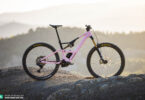What is the E-MOUNTAINBIKE City Escape series?
E-MOUNTAINBIKE City Escapes powered by Haibike visit the world’s most exciting cities to bring you inspiration, insider info and the best tips and tours. In cooperation with Haibike, our goal is to inspire a new generation of riders to embrace a new lifestyle and opportunities. We explore the world’s cities with a different perspective to find the most exciting opportunities to experience them – whether you’re a tourist or a local!
Each E-MOUNTAINBIKE City Escape guide aims to inspire you in its own way. Get to know new facets of major cities, eat at interesting restaurants and discover the best-kept insider secrets: the local language and slang, dos and don’ts, cafes, bars, restaurants, bike shops and of course, GPX files of the best routes to explore. With every City Escape we also present the bikes that we used to get around.
Dive into the following six chapters:
- 1/6 A city of explorers: Somewhere between Vasco da Gama and overtourism
- 2/6 Come on down to Portugal: When father and son go out…
- 3/6 Paradigm shift: Is eMTBing the new surfing?
- 4/6 Lisbon in December: All trails lead to the sea!
- 5/6 Food and drinks: Cafes, bars, restaurants, dos and don’ts in LX
- 6/6 Escape faster: Our electric vehicles in detail

1. The city of explorers – In turbo mode between Vasco da Gama and overtourism
A ship’s horn blows in the distance. Seagulls circle in the sky. An aeroplane flies over an apartment block. The warm sun dazzles us and covers the city in a warm glow. Where the Iberian Peninsula meets the sea, these are the scenes of a normal winter’s day. We’re in Lisbon! A metropolis with many names and an even richer history. The city of seven hills. The city of light. Or simply, currently the hippest capital in Europe.
The iconic Ponte bridge has often caused confusion on Instagram. Due to its similarity with the Golden Gate Bridge, it’s easy to mistake Lisbon for San Francisco in photos. The Jesus Cristo Rei statue towering on the opposite bank only adds to the confusion, leaving you thinking you might have landed in Rio De Janeiro. With its antique tramway, narrow streets and ornate and often colourfully tiled facades, Lisbon has a unique charm that’s so romantic it could have been taken straight from every globetrotter’s dream of the real and authentic. And it is, at least in winter. In peak season, the reality is different: crowded trams, hectic conversations in the hustle of the streets, tourists outnumbering the locals.
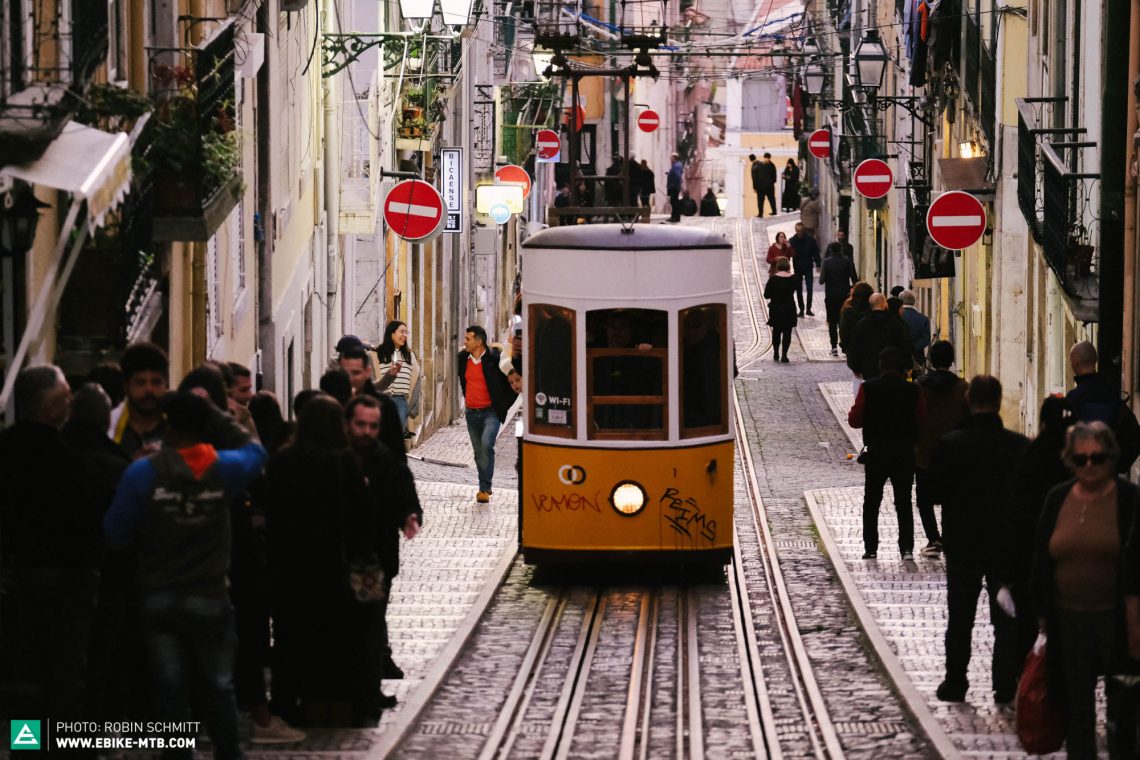

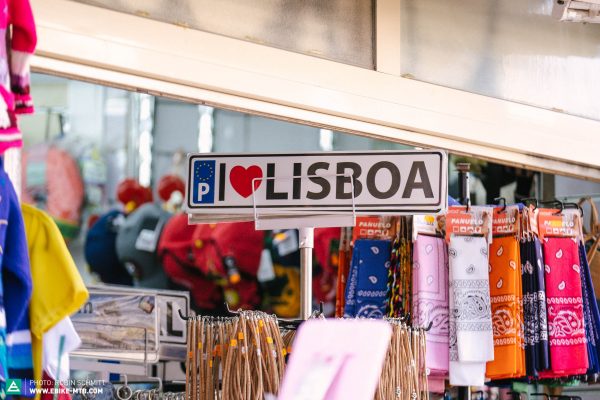
Although Lisbon has so much more to offer than your standard tourist traps, a typical tourist’s itinerary often consists only of Tram 28, the historic elevator de Santa Justa and pastéis de nata.
Like most hip holiday hotspots of today, Lisbon is defenceless against overtourism and gentrification. The problem in Lisbon is that it fosters inequality. While cafes, restaurants and accommodations seem inexpensive to tourists, life for the citizens of Lisbon, with an average gross income of around € 1,500 per month, is becoming less and less affordable. The result? Just as apartments in the hip districts of Berlin are being snapped up by well-off buyers, foreigners buy up properly in Lisbon’s centre and inflate the rent, making it unaffordable for most Portuguese citizens. Sadly, that means the population of locals is dwindling in the city centre. Fortunately, the purpose of our City Escapes is to escape stress, mass tourism and your standard tourist itinerary to instead find the city’s authentic moments.

Lisbon is a small city with a rich history. In 1498 Vasco da Gama set sail from here to discover the maritime route to India, setting the foundation for the Portugese colonisation in the Americas,, Africa, Southeast Asia, India and Chin. As the first empire in the world and the longest-lasting colonial empire in Europe, entire countries such as Brazil, Mozambique or Angola were occupied by the Portuguese. There, they dug for gold, traded spices and, above all, expanded their reign. They also brought back seeds and plants, whose descendants now provide shade in the Jardim Botânico Tropical, which was founded in 1906. Now, only the coat of arms, Fado music and monuments tell of the city’s and country’s former glory.
Inspired by the city’s spirit of discovery, for this E-MOUNTAINBIKE City Escape we swap ships for bikes, conquering Lisbon aboard Haibike’s brand new Xduro and Sduro, both powered by Bosch’s Performance CX motor. We admit we didn’t stay completely dry when we crossed the Tagus by water taxi and lost our bearings in the city’s clubs a few times… In Lisbon, timing is everything. You’ve got to be with the right people, at the right time, in the right place. As we explore the city, we meet with locals and incomers alike to find its hidden treasures, ride trails with the local guiding crew, WeRide and surf with legends.


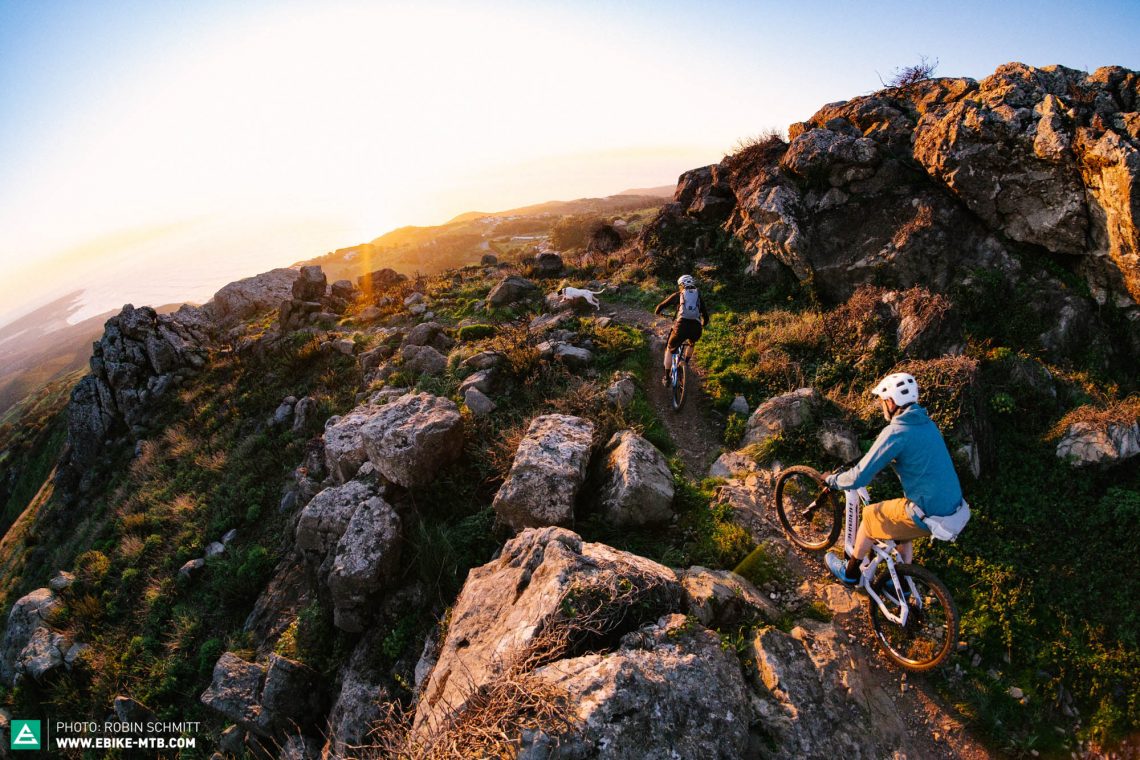
With a population of around 500,000, the city attracts more than 4.5 million sweaty visitors a year, shoving each other through the narrow streets at a sweltering 40° C. If you live here, you’re outnumbered. However, the city comes to rest in winter as very few people find their way to Portugal’s capital during the “cold” months from November-February. This undoubtedly makes it the best time to see the capital, its museums, parks and trails. With average temperatures ranging between 12-14 ° C, predominant sunshine and a low chance of rain, you’ll only have to contend with the locals. Not far away, surrounded by a fairytale forest, Sintra with its old palaces and ancient relics is much more pleasant to see in the off-season too. Instead of waiting in the blazing summer heat for what feels like hours to board a train from Lisbon to Sintra or visit one of the pompous palaces, you’ll never have to queue for more than two minutes in winter.

So what exactly distinguishes Lisbon from other European capitals and what makes it such an unforgettable city escape? The mild weather, the extraordinary hills of the city, the varied trails and the sea offer something for everyone. You can do it all in Lisbon. Just outside (or even in) the city, you’ll find places to surf, kite, bike, skate, paraglide or just go hiking. Just take Monsanto park, which is easily accessible and full of short but sweet trails that the locals look after and maintain. If you prefer to stay in the city, you won’t be short of impressive views, authentic restaurants, Fado, old-fashioned trams, custard tarts and colourful azulejos, the colorful ceramic tiles adorning many of Lisbon’s buildings. Life is literally waiting on your doorstep and thanks to its manageable size, Lisbon, shortened LX, feels more like a big village, where you can experience everything within walking distance.



Lisbon embraces slow food wholeheartedly, offering cuisine that is like grandma’s best home-cooked food and defiantly opposing big chains. With freshly caught fish or meat available everywhere, this is an intrinsic part of Lisbon’s identity. You won’t find run-of-the-mill food-chains here, though, admittedly, there’s still no escaping McDonalds. But in the city’s small Tascas, the TV’s are always on, the neon lights set the mood and you can eat a lot for a little. Popular dishes include caldo verde (cabbage soup), grilled sardines and anything with lots of fish, meat, mussels or crabs. Even vegans and vegetarians will find something to eat. Developing rapidly over the last few years, you’ll find new, hip restaurants popping up in the city’s old facades almost every day.
With the 7 hills at our front door, the ocean behind us and the sun in our faces, there was nothing to stop us from turning on our bikes and heading out to explore the area. As luck would have it, Julian, our art director knows his way around Lisbon, seeing as the city has been his winter escape for two years now. We conquered the city together with him, his dad and Joao, a local and founder of WeRide.
2. Come on down to Portugal! – When father and son go out…
Sometimes, Christmas makes us have the best ideas. “Dad, you should just come down here. To Portugal!” Hop on a plane and escape the miserable weather! He was lucky. Window seat on a direct flight. Three days in Lisbon, the day after Christmas Eve. A Christmas present. A gift for both of us! Aboard two new eMTBs, the age difference shouldn’t matter. Or so I thought…
As art director of E-MOUNTAINBIKE, I have the opportunity to spend my winters in Lisbon thanks to my flexible work structure. Trails that end in the sea, waves hitting the reefs and sun that just keeps on hanging around have long persuaded me to spend the winter months in Portugal’s capital. For me, this city is no longer an insider tip, but the logical place to be if you’re looking to escape the winter. By now, it feels like home and I know my way around. So it was time to show my dad the azulejos, the Fado and the trails.

With a rental battery in the trunk and 15° C in the shade, I wait at the Lisbon airport with the sliding door open. I have to be quick as I’m not allowed to park here for long. After a delayed flight, my dad comes out of Terminal 1 with his bike bag in tow, as if we’d planned it that way. A helmet dangles from his hand luggage and his blue, flat pedal cycling shoes are already on his feet. Perfect, we can head straight for the trails!
“Shit, your car is dirty!” My dad’s always been direct. I always know what he’s thinking because he tells me! There’s no mistaking what the time is either. The sun is starting to set and we have to make the most of it. So, we jump in, drive home and change, ready to ride our bikes up and down, over and under.



Put the helmet on dad, let’s go!
Once in the city, we start our ride under a bridge in the Santos district. Far to the left on the map. More specifically, under Ponte 25 Abril. It is the third-longest combined road and rail traffic suspension bridge in the world. It stretches across the Tagus estuary, named after the date of the Carnation Revolution, a military coup directed against the authoritarian dictatorship that ruled into the 1970s, ushering in free democratic elections and rewriting the constitution. Painted red, it is one of the city’s most photographed attractions, connecting the hip district of Alcântara with the suburb of Almada.
On a newly paved bike path along the Tagus River, you pass joggers, e-scooters and stands selling macaroons as you head towards the city centre. By now the sun has already started slipping behind the horizon. We stop and enjoy its last warm rays on the banks of the river. Then we shift up a gear.
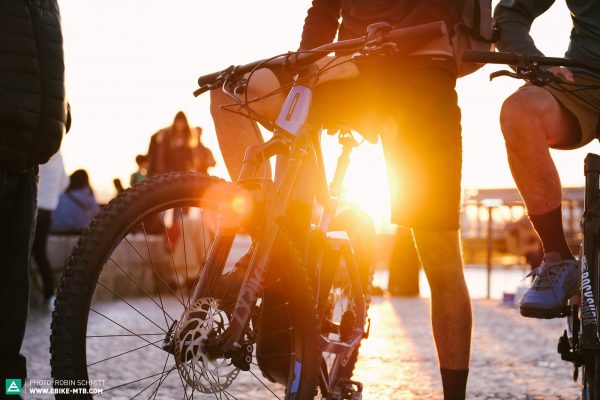


Five minutes. That’s all it takes to get into the centre of the action. In Lisbon, nothing is more than a stone’s throw away. The city centre is packed with stairways, cobblestones, old walls, traffic jams and streets so narrow you have to fold in your side view mirrors. With our bikes in Turbo mode, we ride slalom through the jammed traffic. Dad is loving it, at least it seems he is judging by the motocross noises he’s imitating, pretending he’s cranking the throttle.
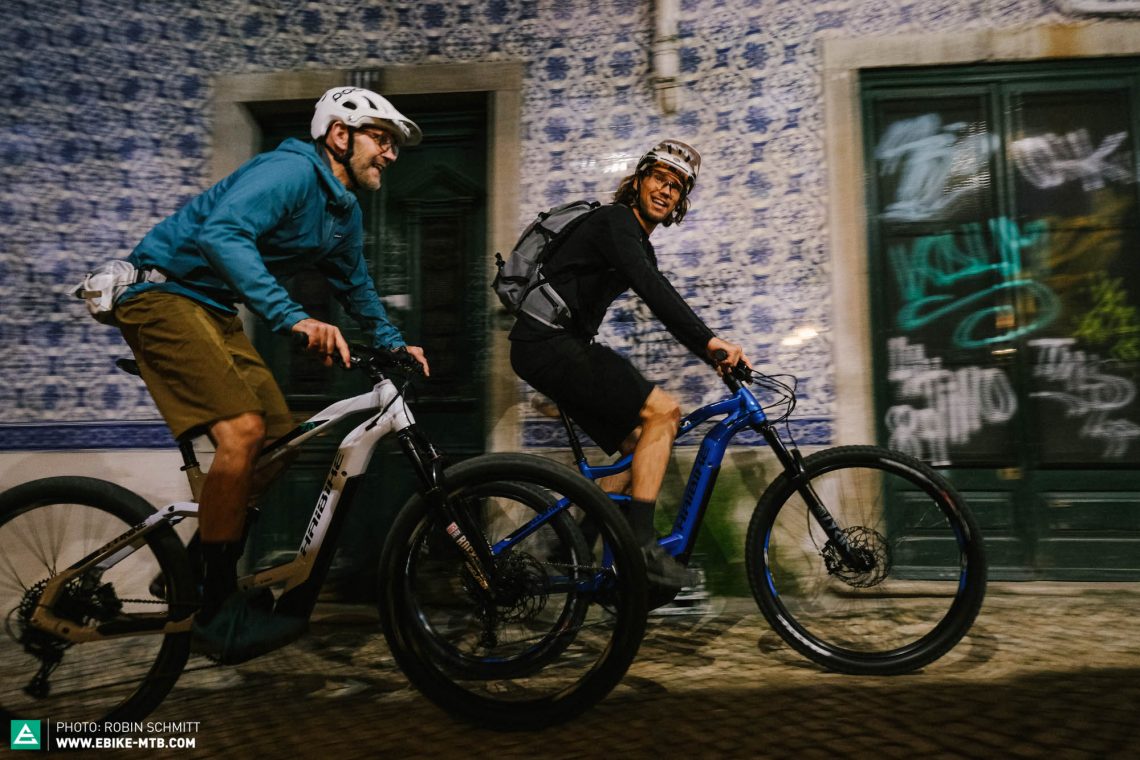
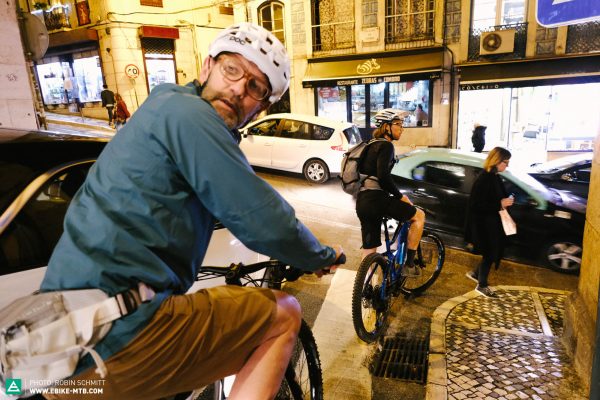

Save battery capacity and hold on! We let the tram pull us up the mountain on its 900 mm track, taking us into the crowded alleys of party goers. Bairro Alto is a hotspot for pub crawlers, frequented by those looking for a great time. Most of them are young exchange students from all over the world. We ignore the age difference and treat ourselves to a quick beer. Saude! And we’re back on our way. We tap the brakes only lightly before left-right cornering combos as we weave through the houses, spurred on by the growling of our bellies. “Attention! Priority to the right!”
After what feels like 15,000 steps descending later, we hit the brakes and lean our bikes against a piece of street art made by Vhils using explosive charges. We’re in a courtyard that smells of curry and cannabis. A small oven warms our calves. We might be in Lisbon, but it’s still December. The menu of the adjoining restaurant has something for everyone, even for those who don’t eat fish or meat. One of everything please and two beers!



As our hands get colder, the music in the bars gets louder. Time to move and order another round of drinks! Off to Le Baron! Previously in Paris, they’ve now moved and rolled out the red carpet in Lisbon. Red neon lights, chairs covered in velvet and dancing to funky disco tunes on carpeted floors. The disco ball sets the mood, my father, the pace! We dance, laugh and drink until the bouncer turns on the lights. We’ll pay for it in the morning!


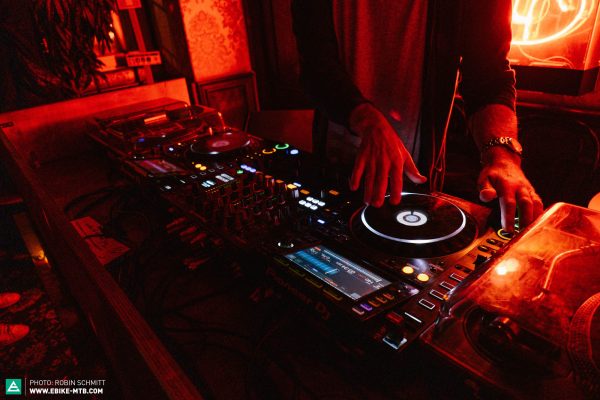
Croissant and coffee for the hangover. The sun is high in the sky and we’re feeling light-headed on our bikes. This morning, we set our sights on the Alfama district. A labyrinth of some of Lisbon’s weightiest historical buildings. Formerly the poor district, today it’s a must-see on every tourist’s itinerary. It’s better to get here early if you want to avoid pushing your bike!
Wallride, alright!



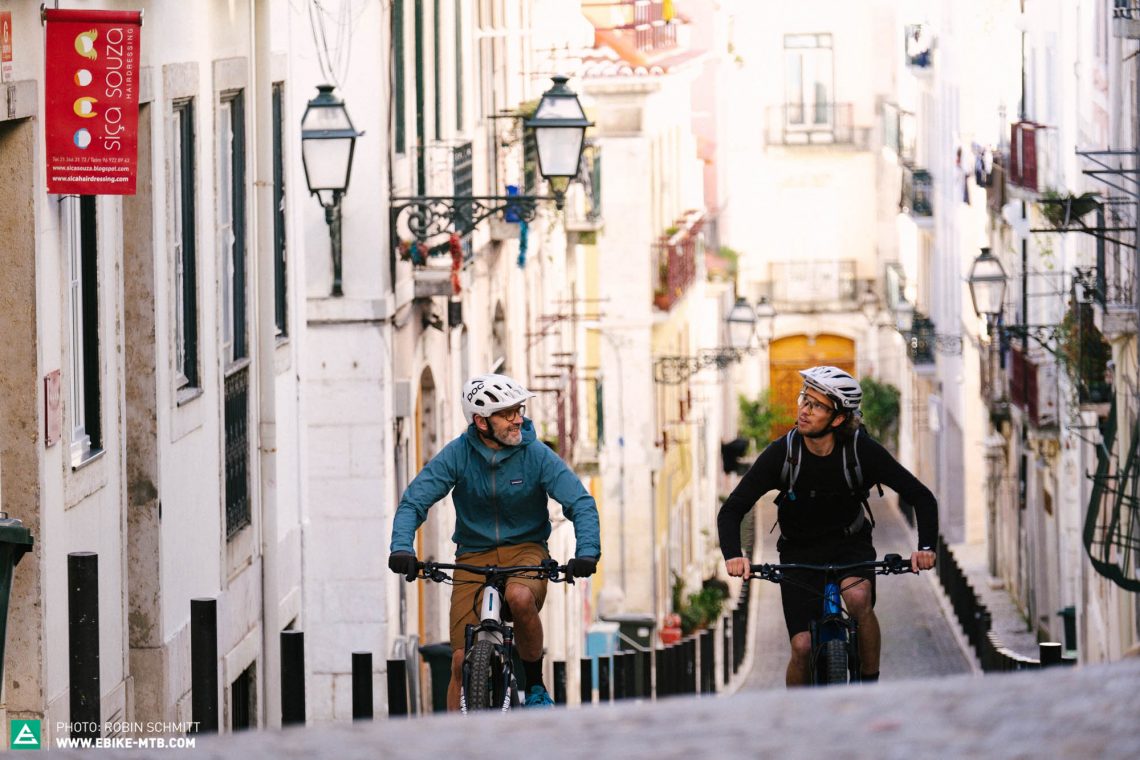

I realise this morning that my dad has more street cred than I do. He goes higher on the wallride and lower in the club! He enjoys the urban jungle, I prefer the forest. We order a quick coffee at a kiosk, pull up our knee pads and roll down the mountain towards the west. We quickly get out of the city, into Lisbon’s green lung.

Covering an area of 800 hectares, Monsanto Park is now a local recreational area for city dwellers. Easily accessible, it lets you forget that you’re in a capital city. You can reach Monsanto’s highest point in less than 10 minutes. We enjoy the view of the city from the roof of an abandoned restaurant and take a moment to appreciate the time we’re spending together. I often find that our conversations have been reduced to me phoning only when I need help with something. Either because my car broke down or because I don’t know which way around the dowel is supposed to go in the wall. It’s good to just spend time riding bikes with my dad for a change. After all, he’s the one who introduced me to biking when I was still into soccer. Two energy bars and several memories of past bike holidays later, we get back on our bikes and head down towards the city. We blast down the trails. As always, my dad sets the pace and any age differences are quickly forgotten!



Life is fast in this slow city. As we all know, time flies when you’re having fun. As does our trip, which ends with even more custard tarts, which, by the way are called pastel de nata. Despite doing a lot of exercise, we must have gained between 1 and 2 kilo in three days. Thanks to Lisbon’s excellent kitchens!
eMTB tours Monsanto
You can find the Komoot tours right here
3. Paradigm Shift – Is eMTBing the new surfing?
When Luis Carvalho shapes a surfboard, he dances. Step by step, the 51 year old carves away gently and precisely at the edges of the future surfboard. In his small workshop, he occasionally takes one step back and two steps forward. In that moment, he is completely immersed in his own world.

n the 70s, surfers here had an image similar to punks.
They were seen as a problem.
When asked how many boards Luis and his colleagues complete each year, he laughs and shrugs, “Three to six a day maybe?” He only knows the number of boards that he has made himself – around 600 surfboards!


Bullfighting, still widely well-regarded decades ago, is what got Luis into surfing. He saw daredevils challenging bulls on television and realised he felt a similar feeling in the waves. On the days his family spent by the sea, Luis stood in the water and let the waves crash against him. One day, he saw someone on the horizon, kneeling on a lilo and gliding down the face of a wave. While this seemed like a revelation to Luis, to the rest of the beachgoers it was nothing more than a punk, wasting his time. But for Luis,these social norms didn’t matter. He viewed the relatively unknown sport without prejudice or judgement. His first thought was, “I have to try that.” And that’s how it all started. What followed was about two years of surfing on the same kind of lilo, followed by the first wooden board that Luis’ grandfather helped him make. Today, Luis has his own surfboard brand called Lacrau, which also supplies boards to some German pros.
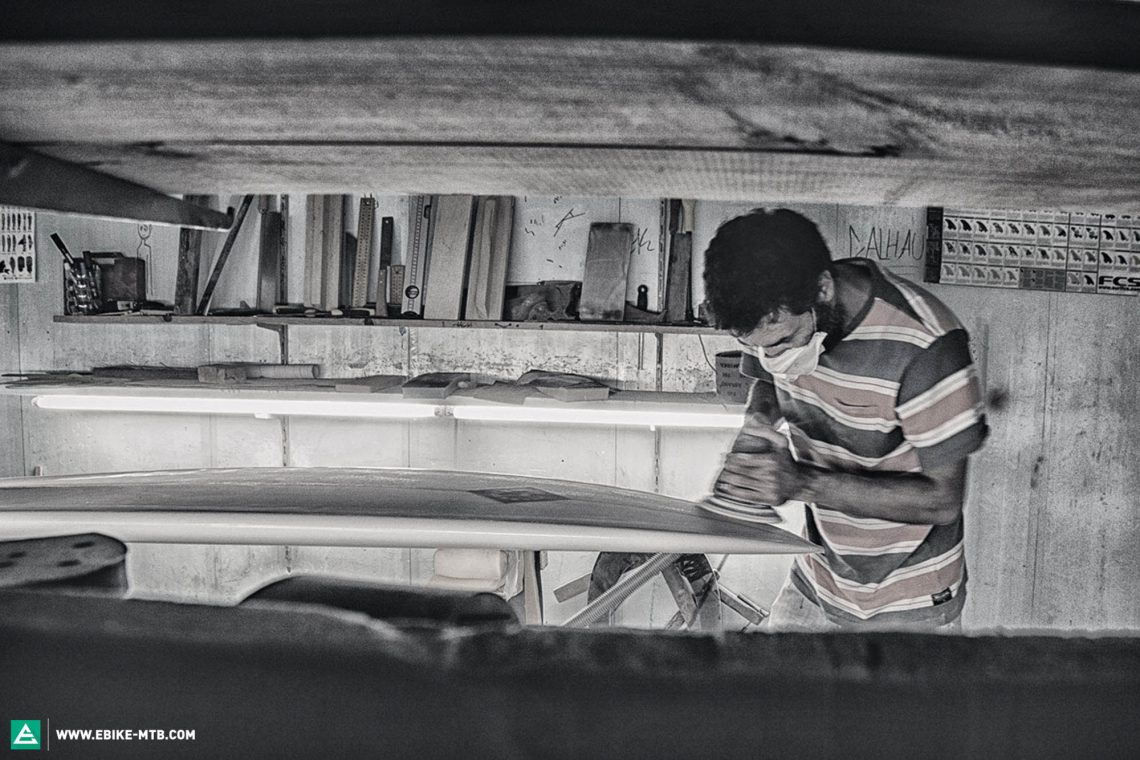
Between epoxy resin, hard foam and sandpaper, we see the glinting eyes of a person who has been a part of Portugal’s surfing scene from day one. The material, styles and outfits have changed drastically over time, says Luis, but the change in attitude towards the sport is what excites him the most. As he talks us through Portugal’s surfing history, he often shakes his head and laughs. The changes that he’s seen the sport undergo are almost beyond belief.
In the past, surfing was prohibited here! Parents were ashamed of their children when they rode the waves with their boards!
40 years ago, Luis shared the waves with around forty other outlaws. Now, when the conditions are right it’s more than 300. Where once you were handed a fine for surfing, today, you’ve got signs pointing you to the next surf spot. There are even special, more spacious compartments on the trains for surfers. Blue signs on the train indicate that surfboards are welcome. Cascais, the self-proclaimed “Capital of Surf” isn’t far from Lisbon and has become a mecca for millions of surf retreat tourists from all over the world. This acceptance was hard fought for in the 80s, whereas today surfers are welcomed.



Perhaps we can derive the future of eMTBing from the past of Portugal’s surfing. If you look closely, this sport is also undergoing rapid changes. Ridiculed at first, demonised and rejected by prejudiced mountain bikers, eMTBing is currently becoming one of the hottest pastimes, leading the technological charge of the outdoor industry. Today, you’ll hardly hear talk of acceptance. Instead, it’s been replaced by fascination for the new-found sense of freedom and possibilities that eMTBs open up. EMTBs are not only changing the way we spend our free time but also our day-to-day lives.
Luis rarely surfs the waves anymore. Rather, he dances on them. With a feeling of freedom and weightlessness, he glides across the water’s surface on his longboard, taking one step back and two forward. We feel the same way when we think of riding our eMTBs. That feeling of freedom as we surf the trails, the unlimited possibilities of being able to conquer every mountain and to have as much fun going uphill as we do going downhill – regardless of wind speed and tides. For some, eMTBing is a step back, but for us, it’s two steps forward!
4. Lisbon in December – All trails lead to the sea!
At the westernmost point of the European mainland you will find a labyrinth of mountains and valleys that look like a fairytale forest and previously thought to be the edge of the world. Today, it is a UNESCO World Heritage Site and tourist trap. The Sintra nature reserve, bordering on Lisbon, is every romantic’s dream with its palaces, though it also attracts mountain bikers with its steep descents and ocean views.



In summer, the queue for the train from Lisbon to Sintra is often longer than those in front of Berlin night clubs. And if you’re not careful, you’ll miss the real party. Blinded by magnificent buildings and castles, many overlook the reserve’s natural beauty – lush forests full of ferns and eucalyptus, still hiding relics from ancient times. Winding through it all you’ll find both beautifully shaped and natural singletrack – every rider’s dream.
The previous evening’s indulgence is still weighing down our legs as my father and I select Turbo mode for the first time that day. “We’ll be late again.” Yesterday we chased the sunset through the narrow streets of Lisbon, today we do the same in the rambling nature reserve of Sintra. After a hearty brunch in Lisbon, we thought that we’d be fit enough to explore this trail paradise in the afternoon.

Without a motor, I would have had to stop here. After what feels like the steepest climb in the park, we meet WeRide guide João Mourão in a high-altitude parking lot with a breathtaking view of the Atlantic. With a warm, “Hey guys, vamos à praia?” he greets us while soaking in the sun at the shuttle bus. We hug and give him the short version of last night’s escapades in Lisbon as we roll towards the trailhead. 50 meters, two panorama shots and one selfie for the family album later, it is time to pull up the knee pads. We follow a single track that trails off beyond the horizon as we look ahead. “Come on guys, let’s have fun.” What follows are endless switchbacks on steep slopes, rock gardens and small jumps, all heading towards Europe’s westernmost tip.



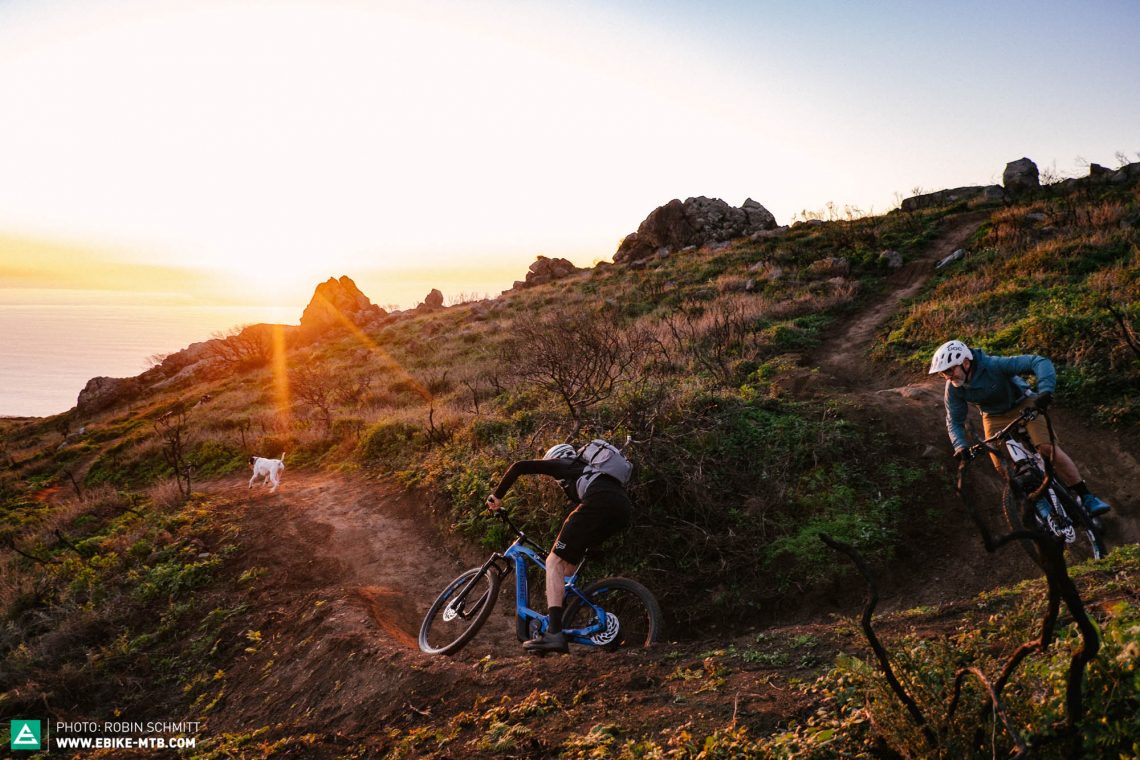
The sun hangs low in the sky as we surf the dusty trail towards the Atlantic. The trail eventually leads us through a recently burnt down forest, all the way to the beach. We’re finished! When we arrive we give each other high-fives, leave our cameras in our backpacks and enjoy the view. But rest assured, where the world was previously thought to come to an end, it continues 😉
eBike tours Sintra
You can find the Komoot tours right here
From the end of the world to the other side of Lisbon
My girlfriend, Stephanie has had enough! She’s heard and read enough about eMTBs. She just wants to try it out. Since dad is still out buying souvenirs for the family, we quickly grab his bike to climb the shore on the opposite side of the city. She’s a bit too small for dad’s bike, but the size of her astonished grin when she first steps on the pedals makes up for it.



You can’t help but be amazed your first time. Neither can Stephanie! Aside from the red Uber ebikes, bicycles are a rare sight in Lisbon. The city’s seven hills make riding here difficult and usually, taxis are her preferred form of transportation. But after the first few meters on the Haibike it’s clear that this will not be the last time she rides an ebike. She looks astonished every time we ride uphill, cheering “wooohuuu!” Her joy echoes through Lisbon’s streets as we head towards the harbour.


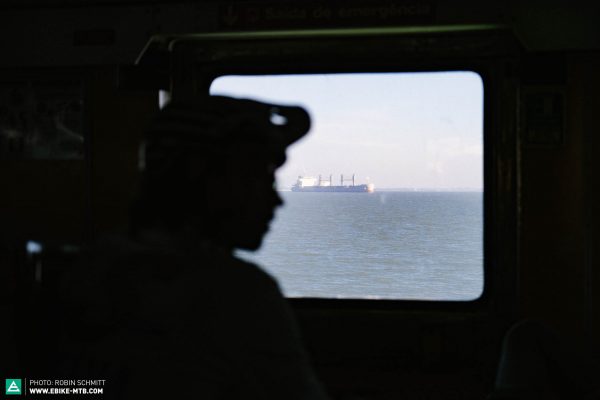
Once at the docks, we take the ferry to Almada on the other side. What about the bikes? Take them with you! While we aren’t charged extra for the bikes, we do have to buy a ticket for our trail dog, Bonnie. Fifteen minutes later we are enjoying the view of Lisbon from the opposite shore. Passing the first restaurants, we cruise along the pier and watch fishermen do their thing. We stop to soak up the sun while enjoying a glass of wine with a dish of fish and vegetables.



As I said, Lisbon has many names. But the capital of Portugal is one thing above all – the city of light. It entices you to pull out your camera and capture its colourful facades and the reflections of light dancing across the river at sunset. Whether we’ve got our cameras ready or not, we take in the sights from Coreto de Almada, a viewpoint above the restaurants. Usually, the climb up here is long and steep, but today it feels short and effortless.

We choose the more decadent but still cheap form of transportation via water taxi back to the city. € 10 per person, including bikes and dog. You get picked up on the beach and skipper Miguel from Taxi Boat Rio lifts the bikes onto the boat himself! Accompanied by funky music and the sound of a 90 HP engine, we head back home under the Ponte Bridge cast in a dreamy light.



Lisbon can be so beautiful, especially when you head away from the worn-out tourist attractions and let yourself drift. Go and discover the hidden treasures of the city and the surrounding woods for yourself, at your own pace. Wander through its alleys without an agenda, stroll through its markets and let the locals inspire you. Watch the sunrise on one of the countless miradouros and the sunset on one of the golden beaches. Just have a good time and don’t stress yourself. Come on down to Lisbon, visit Sintra and Cascais. Obrigado! Ate já!

5. Escape Essentials – Cafés, bars, restaurants, dos and don’ts in Lisbon



Bike shops
JUSTBIKES (Lisbon)
Where Rua dos Bem Casados 6, Massamá, Lisbon, Portugal 2745-751
Web justbikes.pt
Flow Bike Shop (Sintra)
Where? Rua Tomé de Barros Queiroz, 31-A, Sintra, Portugal 2710-624
Web @flowbikeshopsintra
Bikes & Beer (Monsanto)
Where? Rua Tenente Coronel Ribeiro dos Reis 4A (3.01 mi), Lisbon, Portugal 1500-588
Web @bikesandbeerpt



Food & drinks – Breakfast/Lunch
Fauna & Flora – Come here if you’re looking for delicious coffee and a healthy brunch. Excellent option for the vegetarians and vegans among us.
Very insta-friendly!
Where? Rua da Esperança, 33, Lisbon, Portugal 1200-65
Web aunaeflora.eatbu.com
COMOBA – Hip cafe with delicious and healthy snacks, as well as pretty decent coffee!
Where? Rua de São Paulo 101, Lisbon, Portugal 1200-430
Web @comobalisboa
La Boulangerie – Yes, we’re in Portugal, but there is no getting around the croissants and the beautiful terrace of the boulangerie!
Where? Rua do Olival, 42, Lisbon, Portugal 1200-742
Web @laboulangerie.lisboa
Dede’s – Hidden restaurant with a small selection of dishes.
We can recommend everything on the menu, but Dede’s Bowl was our favourite!
Where? Rua de Sant’Ana à Lapa 33B, Lisbon, Portugal 1200-796
Web @cafededes



Dinner
(Reservation recommended)
ÁGUA PERLA BARBA – In the heart of Lisbon, right next to the historic “Bica” railway, you will find a small restaurant completely dedicated to the sea. Small, cosy and delicious.
Where? Rua do Almada, n.º 29/31, Lisbon, Portugal 1200-109
Web @guapelabarbarestaurante
BouBou’s – Our favourite! A slightly more expensive restaurant with an open kitchen, courtyard, super tasty dishes and really good service. Perfect for a romantic dinner!
Where? R. Monte Olivete 32A, Lisbon, Portugal 1200-280
Web lisboninsiders.com
Pistola y Corazon taqueria – Young and cheerful taco restaurant. Perfect place to start the night. Eat with your hands and treat yourself to a Mexican beer.
Where? Rua de Boavista, nº 16 – Freguesia: São Paulo – Cais do Sodré (1.29 mi), Lisbon, Portugal 1200
Web @pistolaycorazontaqueria
Panda Cantina – Modern Chinese restaurant in the heart of Lisbon. Eat ramen here and choose how spicy you want it. On the hotness scale of 1–5, we already started sweating at 2!
Where? Rua da Prata 252, Lisbon, Portugal 1100-052
Web @PandaCantina
Atira-te ao Rio – Small friendly restaurant with food to share! Take the ferry (Cacilhas) to come for lunch and enjoy the view of the city.
Where? Cais do Ginjal, nº 69/7, Almada, Portugal 2800-284
Web atirateaorio.pt
O Gambuzino – For the herbivores among us. Eat super delicious vegan and vegetarian dishes in a relaxed atmosphere. Our go-to veggie restaurant. Our trail dog Bonnie was also very welcome. Cool!
Where? 5A Rua dos Anjos, Lisbon, Portugal 1150-030
Web @ogambuzino
Tantura – This one is fantastic! Super tasty mediterranean israeli cuisine, in a relaxed atmosphere. Dishes can be shared easily.
Where? Rua de Trombeta 1D, Lisbon, Portugal 1200-050
Web @ogambuzino


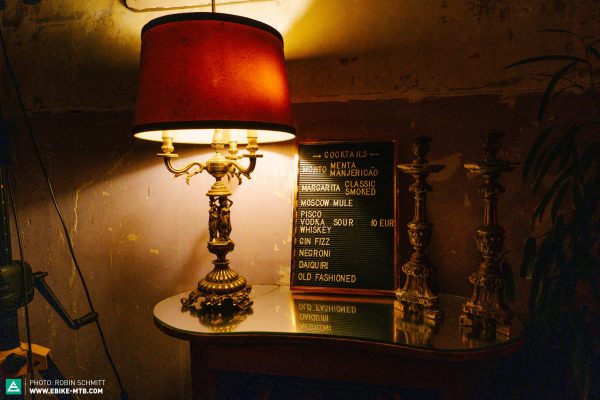
Bars
Le Baron – Formerly notorious in Paris. Groovy and smooth in Lisbon today.
Cocktail bar with funky tunes, carpeted floors and red light.
Where? Rua Nova da Trindade 5, 1200-443 Lisboa
Web @Le-Baron
PURISTA BARBIÈRE – Barbershop with bar and relaxed vibes. Before you start the night at the Baron,
you can always drop by here for a quick drink or two.
Where? Rua Nova da Trindade, 16 C Chiado, 1200-303 Lisboa
Web @PURISTABARBIÈRE
Foxtrot – Rumour has it that this is one of Lisbon’s oldest bars. A cosy retro look with a huge selection of cocktails. Formerly an insider secret, today it is relatively known for its authentic atmosphere. You still have to ring the doorbell 😉
Where? Travessa de Santa Teresa 28 | Bairro Alto, 1200-405 Lisbon
Web barfoxtrot.pt
Casa Independente – A bar with a cultural program and superb ambience. Here you can eat, drink or simply listen to good music. Be careful, if you come late you have to queue.
Where? Largo do Intendente 45, Lisbon 1100-285
Web casaindependente.com

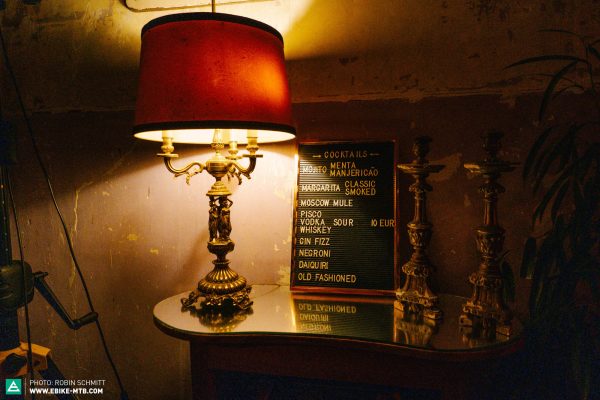

DOS
- aimlessly drift through the city
- enjoy the romantic sunset from the viewpoint or the beach in Sintra
- or take the ferry or the water taxi (€ 10 pp) to the other side of town for lunch (Atira-te ao Rio or Ponto Final restaurant). You can take your bikes with you! It’s best to ask for the water taxi in the restaurant!
- explore the city by bike
- drink Gin Ginja from a chocolate cup
- eat warm pastéis de nata from Belem
- try surfing
- relax
- drive out to Cascais and Sintra
- reserve a table when you go out
DON’TS
- speak Spanish with the locals
- arrive without sneakers
- drive a CityScooter
- arrive in a cruise ship
- go out to eat at McDonalds
- take the tram at peak times
- go out to eat without a reservation
- go to a French New Year’s Eve party

Portuguese for beginners
Obrigado! The Portuguese speak incredibly good English. This is largely due to the fact that films don’t get translated into Portuguese. But if you want to feel like less of a gringo, we have a few basics for you here.
Basics
Hello – Olá
Good morning – Bom dia
Good day – Boa tarde
Good evening/night – Boa noite
Bye – Adeus
All good? – Tudo bem
Yes – Sim
No – Não
Thank you – Obrigado (m) Obrigada (f)
Please – Por favor
You’re welcome – De nada
Sure – Claro
Caution – Cuidado (useful on the bike)
Do you speak English? – Você fala inglês?
I do not speak Portuguese – Eu probl falo português
In the restaurant (or in front of it)
Breakfast – Pequeno-almoço
Lunch – Almoço
Dinner – Jantar
Cheers – Saúde
Bon appetit – Bom apetite!
One beer/two beers please – Uma cerveja/duas cervejas, por favor.
I am a vegetarian/vegan – Sou vegetariano/vegano.
Do you have something vegetarian/vegan – Você tem uma coisa vegetariano/vegano
Chicken – Frango
Beef – Carne de vaca
Beef steak – Bife
Fish – Peixe
Ham – Presunto
Sausage – Salsicha
Grill – Churrasco
Cheese – Queijo
Eggs – Ovos
Salad – Salada
Vegetables – Legumes
Fruits – Frutas
Bread, rolls – Pão
Orange juice – Suco de laranja
6. Escape faster – Our electric vehicles in detail

€ 4,999
Haibike XDURO AllMtn 3.0
The Haibike XDURO AllMtn 3.0 is an excellent bike for trail rides, offering a coherent overall package at a fair price of € 4,999. The bike offers modern geometry, the powerful yet natural feeling Bosch Performance CX motor and an integrated battery capacity of 625 Wh with the option of an external range extender to give you a total 1,125 Wh. Taking care of the gears is a SRAM SX Eagle 12-speed drivetrain and the suspension is provided by RockShox, offering 160 mm travel at the front and rear. The remaining components come from Haibike, apart from the Magura MT5 four-piston brakes and 203 mm rotors, which offer plenty of stopping power.
Price € 4,999
Weight 25.6 kg (size L)
More info: haibike.com





Haibike SDURO FullNine LT 7.0
If you’re looking for an eMTB for day to day chores and leisure time, we recommend taking a closer look at the Haibike SDURO FullNine LT 7.0. Thanks to its RockShox suspension with 140 mm travel and the Bosch Performance CX motor, the bike is super comfortable and relaxed in the city and equally suitable for the occasional trail ride. The motor is powered by a 625 Wh battery, which can be expanded to 1,125 Wh thanks to the Haibike’s Modular Rail System. The moderate geometry keeps the handling agile whether you’re on flowing trails or dodging traffic in the city. However, steep and demanding descents are not this bike’s strong suit. The SDURO FullNine 7.0 costs € 4,999, which gets you decent but more value-oriented componentry, perfect for a bike designed for everyday use. A SRAM SX Eagle 12-speed drivetrain takes care of the shifting and a pair of Magura MT5 four-piston brakes with 203 mm rotors provide all the stopping power you need. Haibike provide most of the remaining components themselves, such as the seat post and handlebar.
Price € 4,999
Weight 25.10 kg (size L)
More info: haibike.com

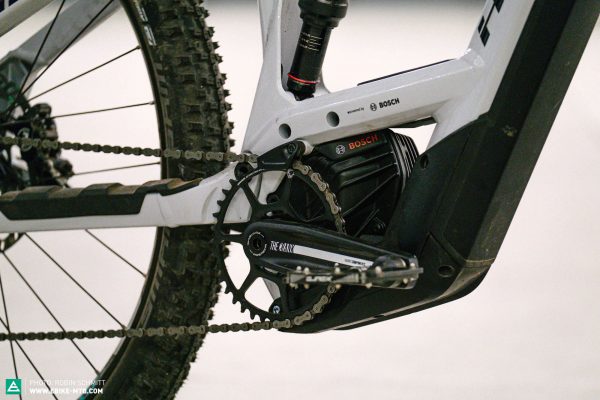

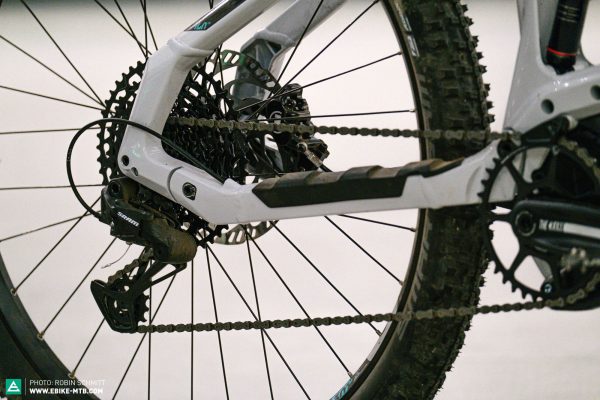
All our City Escapes



Did you enjoy this article? If so, we would be stoked if you decide to support us with a monthly contribution. By becoming a supporter of E-MOUNTAINBIKE, you will help secure a sustainable future for high-quality cycling journalism. Click here to learn more.
Words: Julian Lemme Photos: Robin Schmitt




